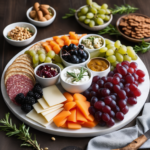A cutting board is a quintessential device in any kitchen. Whether cutting vegetables or meat or preparing a tasty meal, a slicing board is necessary. If you want to know about How to oil a cutting board. Read the article.
However, to ensure the durability of your cutting board and hold its quality, it is essential to oil it regularly. But what oil do you use?
We will discover first-rate oils for cutting boards and supply you with suggestions for perfect maintenance.
Mineral oil
One of the most advocated oils for reducing boards is mineral oil. It is a food-grade oil that does not without problems damage and is odorless and tasteless.
Mineral oil helps seal the wood’s pores, stopping water and microorganisms from seeping in. It is easily accessible and exceptionally inexpensive, making it a famous choice.
Beeswax and mineral oil mixture
Combining beeswax and mineral oil is another awesome choice for oiling-reducing boards. If you want to know about Howards cutting board oil. Read the article.
Beeswax provides a shielding layer to the wood, while mineral oil penetrates deep within, nourishing and moisturizing the fibers.
This aggregate creates an herbal barrier against moisture and bacteria, keeping your slicing board in awesome condition.
Walnut oil
Walnut oil is an herbal oil protected for consumption and presents magnificent safety for slicing boards. It has a first-class nutty aroma and a rich, deep coloration that can decorate the herbal splendor of the wood. Walnut oil is regarded for its sturdiness and resistance to rancidity, making it a dependable choice.
Coconut oil
Coconut oil is a versatile oil extensively used in the kitchen. It has herbal anti-bacterial homes and includes lauric acid, which helps battle dangerous microbes.
Coconut oil is stable at room temperature, so it types a defensive layer on the floor of the reducing board, preserving it secure from moisture and bacteria.
Olive oil
Olive oil is a frequent family oil and can be used for oiling cutting boards. However, it is necessary to observe that olive oil has a low smoke factor and can become rancid over time.
Therefore, it is now different from the exceptional desire for long-term preservation of reducing boards. Instead, it can occasionally add a transient shine to the board.
Avocado oil
Avocado oil is a wholesome and nourishing oil that can be used for oiling slicing boards. It has an excessive smoke point, making it appropriate for high-temperature cooking. If you want to know about What oil to use on cutting board. Read the article.
Avocado oil additionally incorporates diet E, which acts as an antioxidant, stopping the timber from drying out and cracking.
Hemp oil
Hemp oil is an herbal oil that presents high-quality safety for reducing boards. It is rich in omega-3 fatty acids, which assist in keeping the timber moisturized and stop it from drying out.
Hemp oil has antimicrobial properties, making it the best preference for maintaining the cleanliness of your reducing board.
Tung oil
Tung oil is the usual oil used for ending wooden products. It affords a hard, long-lasting end that is water resistant and presents safety towards stains and scratches. Tung oil dries slowly, permitting it to penetrate deep into the timber fibers, growing a long-lasting shielding layer.
Before choosing an oil for your cutting board, reflecting on the professionals and cons of every type is quintessential. Some oils can also require greater standard applications, while others can depart a residue or exchange the look of the wood. Choose an oil that fits your preferences and needs.
Regarding oiling your cutting board, there are a few suggestions to remember. First, constantly begin with an easy and dry board.
Apply the oil generously, using a smooth material or brush, and enable it to soak into the wood for a few hours or overnight.
Wipe off any extra oil earlier than the usage of the cutting board. Regular oiling will assist in preserving the great and expand the lifespan of your slicing board.
FAQs
What is the best oil for a cutting board?
The fine oil for a cutting board is food-grade mineral oil. It is safe, odorless, and no longer flip rancid.
Can I use olive oil to oil my cutting board?
While olive oil is frequently used for cooking, it is no longer advocated for oiling cutting boards as it can go rancid and leave a robust odor.
What oil is food safe on wood?
Food-grade mineral oil is regarded as the most secure choice for oiling wood, which includes cutting boards. It is non-toxic and may not contaminate the food.
Can I use baby oil to oil a cutting board?
No, it is no longer recommended to use child oil for oiling a cutting board. Baby oil includes fragrances and components that are now unprotected from metal contact.
Should I oil my cutting board?
Yes, oil on your reducing board is often essential to hold it well-maintained. Oiling helps forestall the timber from cracking, warping, and absorbing moisture, prolonging its lifespan.
Conclusion
Choosing the proper oil for your cutting board is vital for its preservation and longevity. Mineral oil, beeswax, walnut oil, coconut oil, avocado oil, hemp oil, and tung oil are all incredible picks to shield and nourish your cutting board.
Each oil has its special properties, and it is essential to consider your preferences and wants. Remember to observe the perfect oiling methods and keep everyday care to preserve your reducing board in the most beneficial situation for years.

